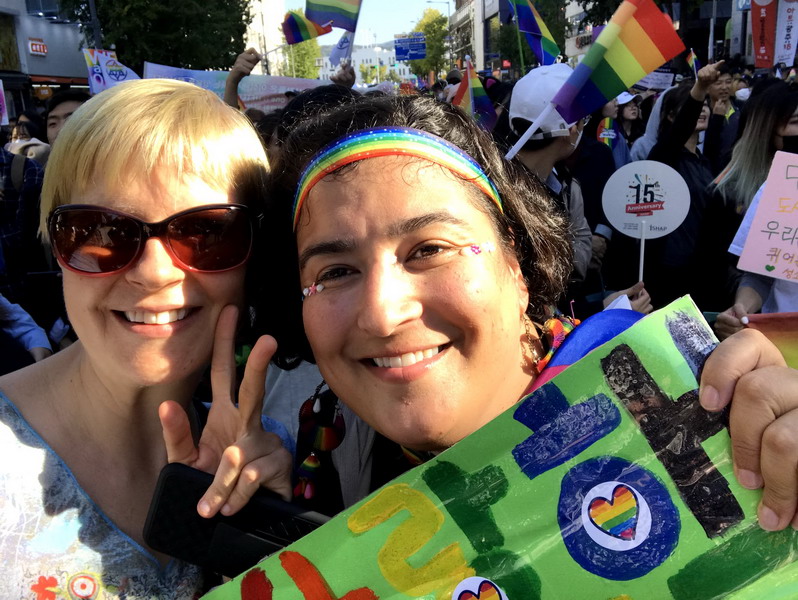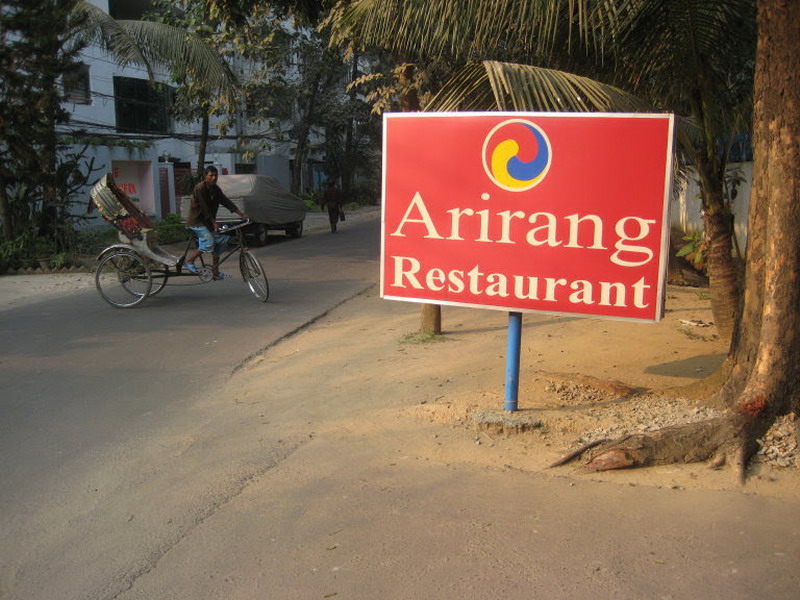The Cosmopolitan Classroom: Transformation Through Encounters with Difference
Interview with Lindsay Herron.
I thought I was aware of what cosmopolitanism entailed, that is, until I saw a presentation on cosmopolitanism and EFL learners at a Korea TESOL event. I wasn’t sure what this meant, but it piqued my interest and I attended the presentation. I came away from the presentation with a broader understanding of cosmopolitanism and how it fits into EFL pedagogy. That presentation was delivered by Lindsay Herron, who has been teaching in Gwangju for over a decade. Though I knew that she was super busy with a myriad of projects, she was finally able to do this interview for the Gwangju News. — D. Shaffer
Gwangju News (GN): I know that you have done a lot of study in cosmopolitanism. When I think of a cosmopolitan, the first thing that comes to mind is someone who is well-to-do, educated, speaks several languages, and travels to many different places. I assume that’s not what you’re studying…is it?
Lindsay Herron: That’s what I used to think of when I heard “cosmopolitan,” as well! But when we talk about cosmopolitanism and cosmopolitan orientations, that’s not exactly what we mean. Cosmopolitan is actually a term that dates back to Ancient Greece and the Stoics; the Cynic philosopher Diogenes (c. 390–323 BCE) is credited with coining the term when he declared himself a kosmopolites, or “citizen of the world,” instead of a citizen merely of the nation-state. The idea was adopted by Enlightenment thinkers, including the influential philosopher Immanuel Kant, to advocate for more universalist perspectives and moral obligations (Hansen, 2014). Today, cosmopolitanism has been embraced by a wide variety of fields, from anthropology to sociology, and media studies to political science, as a framework for understanding the complex intersections and interactions between the local and global.

Most conceptualizations of cosmopolitanism today go beyond the local and global, however, to encompass all the myriad differences that are inherent among us. Philosopher Kwame Anthony Appiah (2006) describes cosmopolitanism as comprising the entwined concepts of pluralism and fallibilism – that is, a recognition of the existence of multiple perspectives and also the limitations of your own. In many ways, cosmopolitanism is about relativizing the self, about viewing yourself and your understandings within larger contexts and from other perspectives. It’s about delighting in difference, seeking out new ideas and experiences, and engaging with others in a welcoming, open way – and on their own terms. It’s also about our responsibility as citizens of the world to act beyond borders with an eye toward our shared ethical obligation to others. If cosmopolitanism had a slogan, Appiah (2006) says, it might be “universality plus difference” (loc. 2206). That is to say, cosmopolitanism is a way to both appreciate and move beyond differences to a central core of shared humanity.
Cosmopolitanism is also about growing and changing through encounters with difference. When we encounter a new perspective, we experience a sense of disjuncture between the new and the known. We become aware of previously unknown paths and possibilities in life, which in turn highlight the limitations of our own taken-for-granted beliefs, assumptions, and biases. As we start to critically consider and question our own enculturated versions of “normal,” we come to understand that “normal” is relative at best – that there are manifold ways of being in the world. This expanded awareness of the world changes us; we approach both new perspectives and old beliefs with a more critical eye, adopting the ones that suit us, while cultivating more hospitable, empathetic, humanizing views of others. Cosmopolitanism in this way can foster community, connection, and belonging as understandings of boundaries, self, and other evolve.

GN: Cosmopolitanism “fosters community” – that’s a nice way of putting it! So, what got you interested in the study of cosmopolitanism?
Lindsay: The first doctoral course I took at Indiana University was a survey course incorporating a wide range of literacy-related topics, including cosmopolitan literacies. The following summer, I took an intensive reading elective on cosmopolitanism that allowed us to delve deeply into and engage with a variety of interdisciplinary perspectives on the topic. I enjoyed this course so much that, as part of my final project, I drafted a research proposal that eventually evolved into the basis for my dissertation.
Cosmopolitanism appeals to me for many reasons. First and foremost, I think it’s an important topic, particularly considering the xenophobia and intolerance so rife in today’s world. With its dual emphases on ethical obligation and criticality, cosmopolitan education seems a promising way to encourage more open, empathetic perspectives; to question what we “know” and believe; to imagine new and better alternatives; and ultimately to build a better world. Second, I love how interdisciplinary it is. As part of my research, I’ve gotten to read books and articles from scholars around the world in the fields of media studies, cultural studies, political science, anthropology, social science, tourism theory, philosophy, philanthropy, and (of course) literacy and education.

The third reason I find cosmopolitanism fascinating is that it’s immediately, viscerally, and visibly relevant to my life (and yours, too, if you’re reading this!). One key aspect of cosmopolitanism, dating back many millennia, is the selective adaptation of global trends to local tastes. K-pop, with its Western inspirations and influences, local performers, and global dissemination? Cosmopolitan! The cafes that dot Gwangju’s streets, serving coffee and European delicacies matching Korean tastes, with hours suiting Korean preferences? Cosmopolitan! The food court at Costco, where Korean customers take the condiments provided as hot dog toppings (onions, mustard, ketchup, and relish), mix them together on a plate, and eat them as a side dish? Cosmopolitan!
Learning about cosmopolitanism has helped me understand the mélange of cultural influences surrounding me here in Korea and also reminded me that fostering a cosmopolitan mindset – especially one that gives others the benefit of the doubt and seeks a deeper understanding of situated practices – is a continuous process. I don’t always manage it, but I find that pushing myself toward more cosmopolitan openness and striving to consider other perspectives can help when I feel frustrated or impatient with life in Korea. For example, to be honest, I used to be fairly disdainful of the “misuse” of hot dog toppings at Costco; since recognizing this activity for what it was (the contextually appropriate creation of banchan) and as a fundamentally cosmopolitan practice, though, I have much more appreciation for it.
GN: Cosmopolitanism is an aspect of society, or societies, but how does it fit into education?
Lindsay: Cosmopolitanism is a popular lens for educational practice today. In many ways, in fact, education is inherently cosmopolitan! In cosmopolitan theory, transformation is spurred by encounters with the new that draw people’s attention to the limitations of their previous perspectives and simultaneously present new possibilities. That’s education in a nutshell, isn’t it? Hansen’s (2014) work on cosmopolitanism explicitly compares embodied cosmopolitanism to education, describing education as “a transformative experience of becoming aware of one’s skills or lack thereof, of grasping their significance or their triviality, of discovering (often with surprise) that knowledge is a more many-sided concept … than simply having information” (p. 10). Researcher Ninni Wahlström (2014) also finds “active, potentially cosmopolitan-minded meaning-making” (p. 130) in classes that encourage curiosity and wonder as students encounter new ideas and thoughts. She describes this as an “aesthetic-reflective experience” that helps students create new meaning, and she encourages a classroom that “includes inner feelings, imagination, and self-reflexivity” (p. 125). The question, then, isn’t really whether cosmopolitanism is related to education but rather how teachers can create in their lessons a sense of embodied cosmopolitanism, that sense of “wonder, triggered by substantive encounters with the new” (Hansen, 2014, p. 9) that encourages new understandings and new meaning-making.

GN: Can you give us some ideas as to how teachers can introduce cosmopolitan meaning-making into their classroom teaching?
Lindsay: It might help here to think of cosmopolitanism as entailing two separate but entwined elements: (a) an ethical obligation to others that might emerge as empathy, openness, hospitality, and a concern for others’ wellbeing (including distant/different others) and (b) the potential for reflective transformation through encounters with difference. These can be achieved by creating opportunities for disjuncture, gently disrupting what students “know” or believe is “normal” to encourage the pluralism and fallibilism described by Appiah. Simply teaching a foreign language and introducing various aspects of other cultures is, in effect, quite cosmopolitan! Our teaching styles, methodologies, educational priorities, and approaches to classroom management are often different from what students have experienced, giving them new perspectives on what “education,” “learning,” and “success” can look like. For foreign teachers, in particular, it can be useful to incorporate stories about our lives, photos of our friends and families, and information about our favorite things, giving students new and varied ideas about what “foreigners” are like. Related to this, I also strongly encourage foreigner teachers to try to disrupt the prevailing stereotypes here (e.g., by enjoying spicy foods, using chopsticks, being able to speak Korean), which can help to highlight generalizations, assumptions, and biases, and thus force students (and our colleagues) to question their understandings and beliefs.
Thinking about cosmopolitanism in this way, it’s surprisingly easy to make your class more cosmopolitan. Here are a few easy adjustments:
— Have students write for an authentic audience, even if it’s just their peers. In order to successfully communicate across difference, an author must imagine their audience and their audience’s divergent experiences and understandings; this is a fundamentally cosmopolitan endeavor that requires consideration of diverse perspectives.
— Make your writing projects (and your classes) more multimodal. This shakes up notions of what “writing” and “literacy” are, challenges more traditional forms of education by privileging different skills and ways of thinking, and requires consideration of diverse perspectives as students choose the best semiotic resource for conveying meaning in this particular context for this particular audience.
— Normalize (and humanize) diverse others through representation of a wide variety of people: people with different backgrounds, abilities, ethnicities, gender identities, family structures, jobs, etc. (Note: Some of these might be more controversial than others; please check with a co-teacher if you think your school might take issue with something.)
— Embrace the social imagination; encourage students to talk, discuss, play, read, and imagine! Interaction with others spurs our “social imagination,” educational philosopher Maxine Greene (1995) writes, which in turn can conjure up “a mode of utopian thinking: thinking that refuses mere compliance, that looks down roads not yet taken to the shapes of a more fulfilling social order, to more vibrant ways of being in the world” (p. 5). In short, discovering alternate paths and patterns of existence encourages us to imagine how our lives could be different or improved – a response to the disjuncture between what is and what could be, and a highly cosmopolitan endeavor in its subtle embrace of criticality and self-problematization.
— Inspire curiosity and wonder! Check out KOTESOL’s many publications and presentations for some wonderful ideas for how to do this.
— Model cosmopolitan openness yourself! Cultivate in yourself a cosmopolitan mindset that recognizes and questions your own limitations and preconceptions, evinces empathy and understanding, and welcomes the knowledge and viewpoints that diverse others – including your own students and colleagues – can offer.
Cosmopolitanism is a massive concept, and I’ve only scratched the surface here. I hope you’ll agree, though, that it seems to be an interesting lens for considering how we teach; what we teach; how students engage across difference with their friends, the material, and unknown others; how we problematize our own understandings and norms; how we understand our place in the world; and how we can improve the world by thinking outside the local and imagining new possibilities.
GN: Fascinating stuff! Really thought-provoking. I can now take a bit of comfort in knowing that my classes had elements of cosmopolitanism sprinkled through them, though I didn’t have that label to put on it. It seems that with their background knowledge and experiences, it’s the expat educator in Korea who can more easily interject more cosmopolitanism into teaching. Thank you, Lindsay, for giving us this multi-faceted explanation of cosmopolitanism; it gives us another aspect to consider – to reflect on – in preparing students for the ever-expanding global community that lies before them.
Interviewed by David Shaffer, Gwangju News’ editor-in-chief.
References
Appiah, K. A. (2006). Cosmpolitanism: Ethics in a world of strangers. W.W. Norton & Company.
Greene, M. (1995). Releasing the imagination: Essays on education, the arts, and social change. Jossey-Bass.
Hansen, D. T. (2014). Cosmopolitanism as cultural creativity: New modes of educational practice in globalizing times. Curriculum Inquiry, 44(1), 1–14. http://doi.org/10.1111/curi.12039
Wahlström, N. (2014). Toward a conceptual framework for understanding cosmopolitanism on the ground. Curriculum Inquiry, 44(1), 113–132. https://doi.org/10.1111/curi.12038
Gwangju-Jeonnam KOTESOL UPCOMING EVENTS
Check the Chapter’s webpages and Facebook group periodically for updates on chapter events and online activities.
For full event details:
Website: http://koreatesol.org/gwangju
Facebook: Gwangju-Jeonnam KOTESOL
The Interviewee
Lindsay Herron has been teaching at Gwangju National University of Education since 2008. She is currently working on a doctorate in literacy, culture, and language education at Indiana University; her dissertation explores the situated cosmopolitan literacies her students demonstrated during a semester-long, online international exchange. Lindsay is currently the president of KOTESOL’s Gwangju-Jeonnam Chapter and a past national president.



